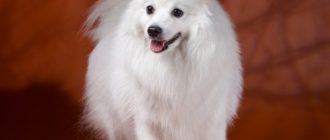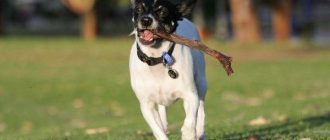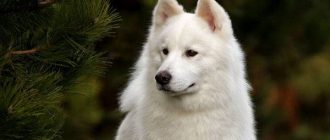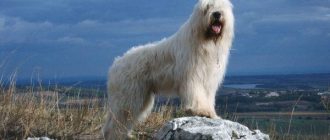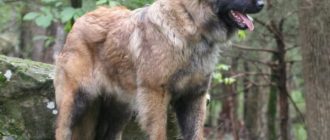Assessment of breed characteristics
Contents
| Adaptability Definition of how easy a dog is. can adapt to changes in life. |  |
| Shedding Level Level and frequency of hair loss in animal. |  |
| Level of tenderness Level and amount of tenderness and affection that the dog gives back in return for attention to itself. |  |
| Need for Exercise Daily Activity Level dogs. |  |
| Social need Required number of dog contacts with other animals as well as people. |  |
| Housing ratio Factor that determines the level of noise and other inconvenience that the dog can deliver to the owners in the ratio the size of the apartment to the size of the dog. |  |
| Grooming Number of bathing, combing, as well as necessary number of professional grooming sessions required the dog. |  |
| Friendliness in an unfamiliar environment society with strangers or in an unfamiliar environment. |  |
| The tendency to bark The tendency to bark and its frequency and volume. |  |
| Health Issues Potential Health Status dogs. |  |
| Territorial tendency of the dog to protect his house, yard or even a car owner. |  |
| Cat friendliness A trend towards cat tolerance and reduced manifestation of hunting instincts. |  |
| Intelligence Dog’s ability to think and solve emerging difficulties (not to be confused with learning!). |  |
| Education and training Level of difficulty in training a dog perform certain actions. |  |
| Friendliness for children Factor determining how much the dog friendly to children, whether she likes to play with them and endure some children’s pranks. |  |
| Game activity The concept is determined by its very name, and, usually found in almost all dogs. |  |
| Observability Dog’s ability to detect presence a stranger in his territory. |  |
| Friendliness for other dogs Dog’s tendency to find common language with other relatives. |  |
Brief description of the breed
Pomeranian acquired its name thanks to Pomerania – a region in northern Europe on the Baltic coast where the dog was first bred. It is worth noting that the ancestors of the pet are large spitz that weighed 10 to 15 kilograms then there is much more than the current dwarf spitz. Pomeranian Spitz:
- Fits perfectly into the family;
- Strongly attached to the owner;
- Can be kept in an apartment;
- Ideal friend for adult children;
- Sensitive, attentive watchman.
Cons Pomeranian:
- Needs careful care;
- Loves to bark;
- Not suitable for small children;
- Can bully other people’s dogs.
Pomeranian (dwarf) Spitz is the cutest animal with rampant curiosity. Dogs of this popular breed weigh only 3.5 kilograms. These are animals with bright eyes, intelligence and temperament. This tiny dog is very smart and active. The owners such a pet will confidently say that he has a large courage than his big relatives. Although he is a dwarf spitz, he adores his family, yet he will not sit at the owner’s feet for long. As the dog is very active, she loves to run on the lawn near the house. Pomeranian Spitz is a great option for those who wish to have a tiny dog that would have the character of a large shepherd or a sled dog from which this breed originates. It would seem because of its small size, even the size of the dog is enough apartments in order to throw out all the energy. However Pomeranian loves to drive around the park, lie in the leaves and play with your relatives. This is a sports dog, therefore quite often Spitz takes part in various sports competitions. The size of this breed allows you to easily contain dog in the apartment, but the animal will feel most comfortable yourself in a private house where there is a private courtyard. Naturally dog Do not hold on a chain or in a separate room. Pomeranian Spitz must live exclusively with his family. Like many others dwarf breeds, Pomeranian – this is the dog that hard enough to train at home. At the time of purchase puppy you need to learn all the features of care and education. Be sure to ask about the puppy’s health status, and also his parents. In the future, all these nuances may be useful. If the dog breeder says that the animal and its parents are nothing If you didn’t get sick, then better refuse the purchase. Most likely you are lying! Be sure to request animal health documents and parents! Pomeranian can be excommunicated already in 8-10 weeks old, but most try to keep a puppy with mother up to 12-14 weeks. This will help ensure that puppies sufficiently formed and ready for independent living away from mothers.
Pomeranian photo:
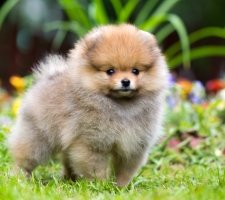

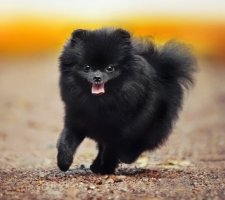


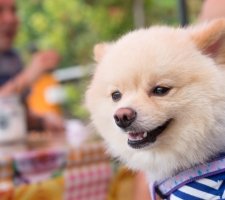



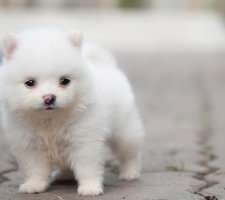
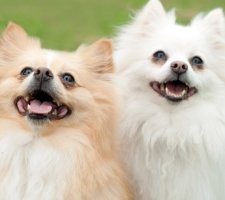
 Photo of Pomeranian Spitz dogs |
Photo of Pomeranian Spitz dogs |
Origin history
Pomeranian spitz originates from ancient times, the so-called peat dog, which is considered the ancestor of not only Spitz, but also many other breeds, for example, Schnauzer. IN Northern and Central Europe Spitz-like dogs were known for a very long time. They were of different sizes and had the most varied color. In Mecklenburg and the expanses of Pomerania medium sized dogs were bred. To england these lovely animals first hit thanks to the princess of mecklenburg who subsequently married King George III. Breeders there went further and began to radically change their growth into smaller side, and the coat is large. Small, fluffy dogs weighing about two kilograms became so famous that the British began consider yourself the founders of the breed. In the place of its removal This breed is called Pomeranian. In 1870 English Kennel Club approved the breed and a year later it representatives for the first time participated in a cynological exhibition. More than twenty years later, in 1898, the Pomeranian Spitz Club in England he developed the first breed standard. Despite this, the breed actively developed in Germany, and in 1899 the Association arose German Spitz, which streamlined differences in breed from the point view of the size of the German Spitz population. First of all, Spitz divided into large and small, which was not enough in later it was decided to divide the breed by size by five types: the largest wolf, then large, medium, small and dwarf (decorative). In the years 1895-1910 was developed European breed standard that was later recognized International Cynological Federation. For everyone, without exception, spitz of any size the same anatomical was approved structure with a difference in growth, which must correspond patterned. Some problems have arisen with a dwarf spitz. IFF not recognized the English Pomeranian as an official breed, but took into account its weight (given that the English standard does not take into account growth), which corresponds to a German small or dwarf spitz, depending on the weight of the individual. After some ICF time approved the name Pomeranian as English breed name. Recognize that dogs from England look more spectacular than their counterparts from Germany. Thanks to their beautiful coat, European breeders are happy are breeding this breed. Probably because of his appearance Pomeranian nowadays enjoys most popular compared to German. Breed standard German Spitz has been updated many times, with the largest the changes concerned the coat color of dwarf spitz, since individuals imported from England gave a very diverse offspring whose color was not originally included in the standard breed color.
Pomeranian character
The weight of a Pomeranian is about five kilograms, but Despite this, the inner world and the nature of the dog are very rich. Pomeranian loves to watch the world around him, he loves sit on the windowsill and bark, thus showing their attention to everything that happens outside the window. Representatives of this breed perfect for people who are willing to play with a dog and give her your warmth and attention. The German Spitz always lived close man, he was used as a guard and shepherd dogs, he perfectly adapted to life in the family and, with necessary, became an excellent companion. Over time, this led to the fact that Spitz strongly attached to their owners. Them easier to locate, they are better trained than hunting spitz and harness. Pomeranian spitz is the smallest representative of the breed among his brethren, however, he is also like they are very smart. Full of energy, constantly in movement, bold and a little pugnacious, completely not associated with fragile, neat salon dog, which seems at first sight. In fact, this animal is quite noisy, funny and Friendly, able to adapt perfectly in any environment. Endlessly attached to the whole family, behaves towards strangers rather restrained, he needs some time to get used to new people and trust them.
Maintenance and care
With regard to care, you should pay attention to the fact that dogs have a very dense double coat, so it requires special thorough and regular care. The rest of the dog care is not complicated. The animal is prone to barking, sometimes it is quite difficult stop! Pomeranian is a breed with a moderate level molting, which occurs once a year. In this case, dogs can start shedding from experienced stressful situations. For normal care of the hair of this breed of dogs is necessary to conduct combing wool twice a week. This amount is optimal for maintaining healthy hair and preventing hair loss wool in the house. Pomeranian spitz is usually cut, but haircuts are made in certain areas of the body (legs, face, ears). Bathing is carried out as necessary. Dogs alone bathe every week, others monthly or even several times a year. Everything will depend on the degree of contamination of the coat. dogs. Dogs of small breeds are prone to problems with with teeth. Therefore, weekly cleaning is required. Regular oral cleaning procedures to prevent loss teeth and will become the key to a pleasant smell from the mouth. Regularly (each week) check your pet’s ears. They should not be suspicious discharge, irritation or inflammation. Auricles are treated a special solution that can be purchased at the veterinary a pharmacy.
Training and training
Pomeranian belongs to those dogs that are trained and it’s not very easy to train. They are persistent, do not like to obey, stubborn. That is why for training you will need demanding, persistent, confident coach. To to smooth out such a somewhat eccentric character, early socialization of the pet. During training, it is necessary to resort to praise and rewards in the form of goodies. Themselves training should not be lengthy, otherwise your pet is all bored. Avoid any manifestation of aggression or negative reactions. If you feel that you are not coping with the training, then contact a professional who is sure to you help. Pomeranian Spitz, by nature – a dog unfriendly and incredulous. She does not like strangers, she is often scared. therefore the issue of early socialization is just as important as the issue of leaving for a pet. Socialization should begin on the first day spitz appearance in the house. If this process start at a later date age, the result will not be so successful. After training basic commands and rules of conduct can move on to more difficult tasks. For example, you can train your pet agility. Do not forget that Pomeranian is very active. Therefore, all exercises during training should also be active. If the dog is bored, then all your attempts will be in vain.
Health and Disease
Dogs of the Pomeranian breed live long enough and, with proper care, can live up to 14 years. Even in old age they differ in good health. Despite its apparent fragility, not very coddled dogs, prefer active way of life, tolerate winter weather, but summer heat and prolonged exposure to the sun is worse. Health problems, which most often arise are usually directly related to small stature. As with all decorative dogs, problems with the musculoskeletal system (knee dislocation calyx or any kind of injury). Injuries more often due to fault owners who must be very careful not to miss your pet or not step on it. Also found very stable baby teeth, prone to dental formation stone, tracheal collapse, as well as alopecia (hair loss), which It is equally common in all Spitz. forget that this small-sized pet loves to eat and has a greater tendency to be full, which can take a long time go unnoticed due to its lush coat. Exactly therefore, you should control the amount of food that eats Your pet, and to make it more comfortable, divide the daily serving in 2-3 parts. The problem of excess weight is reflected not so much on appearance of the Spitz, how much is on his health. Goodies with which you reward your four-legged pet when training, should to be symbolic and applied interchangeably with praises, such your pet will endure a restriction in food much easier than treatment from excess weight.

